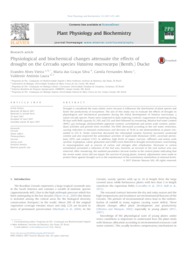Physiological and biochemical changes attenuate the effects of drought on the Cerrado species Vatairea macrocarpa (Benth.) Ducke.
Physiological and biochemical changes attenuate the effects of drought on the Cerrado species Vatairea macrocarpa (Benth.) Ducke.
Autoria: VIEIRA, E. A.; SILVA, M das G.; MORO, C. F.; LAURA, V. A.
Resumo: Drought is considered the main abiotic stress because it influences the distribution of plant species and limits the productivity of ecosystems. The aim of this study was to evaluate the effects of drought on physiological and biochemical parameters during the initial development of Vatairea macrocarpa, a native cerrado species. Plants were subjected to daily watering (control); suppression of watering during 90 days with field capacity (fc) 50% and 25% and then followed by rewatering. Relative leaf water content (RWC), gas exchange, photosynthetic pigments content, carbohydrate and amino acids content, antioxidant activities and growth were recorded. The RWC decreased according to the soil water restriction, causing reduction in stomatal conductance and decrease of 76.4% in net photosynthesis in plants submitted to 25% fc. Water restriction decreased the chlorophyll content, however increased carotenoid content and also improved the antioxidant activities of superoxide dismutase (SOD), ascorbate peroxidase (APX) and catalase (CAT). In addition, high levels of sugars (sucrose, raffinose) and amino acids (proline, tryptophan, valine, glutamine and GABA) were detected in drought stressed plants, contributing to osmoregulation and as sources of carbon and nitrogen after rehydration. Decreases in carbon assimilation promoted a reduction of the leaf area, however an increase in the root surface area was observed. After rewatering, the analized parameters became similar to the control plants indicating that the severe water stress did not impair the survival of young plants. Instead, adjustments were made to protect them against drought such as the maintenance of the assimilatory metabolism at minimal levels.
Ano de publicação: 2017
Tipo de publicação: Artigo de periódico
Unidade: Embrapa Gado de Corte
Palavras-chave: Cerrado, Stomatal resistance, Vatairea macrocarpa, Water deficit plant
Observações
1 - Por padrão são exibidas publicações dos últimos 20 anos. Para encontrar publicações mais antigas, configure o filtro ano de publicação, colocando o ano a partir do qual você deseja encontrar publicações. O filtro está na coluna da esquerda na busca acima.
2 - Para ler algumas publicações da Embrapa (apenas as que estão em formato ePub), é necessário ter, no celular ou computador, um desses softwares gratuitos. Sistemas Android: Google Play Livros; IOS: iBooks; Windows e Linux: software Calibre.
Acesse outras publicações
Acesse a Base de Dados da Pesquisa Agropecuária (BDPA) para consultar o acervo completo das bibliotecas da Embrapa.

